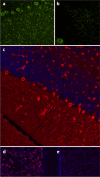Inositol 1,4,5-trisphosphate receptor type 1 autoantibody (ITPR1-IgG/anti-Sj)-associated autoimmune cerebellar ataxia, encephalitis and peripheral neuropathy: review of the literature
- PMID: 35907972
- PMCID: PMC9338677
- DOI: 10.1186/s12974-022-02545-4
Inositol 1,4,5-trisphosphate receptor type 1 autoantibody (ITPR1-IgG/anti-Sj)-associated autoimmune cerebellar ataxia, encephalitis and peripheral neuropathy: review of the literature
Abstract
Background: In 2014, we first described novel autoantibodies to the inositol 1,4,5-trisphosphate receptor type 1 (ITPR1-IgG/anti-Sj) in patients with autoimmune cerebellar ataxia (ACA) in this journal. Here, we provide a review of the available literature on ITPR1-IgG/anti-Sj, covering clinical and paraclinical presentation, tumour association, serological findings, and immunopathogenesis.
Methods: Review of the peer-reviewed and PubMed-listed English language literature on ITPR1-IgG/anti-Sj. In addition, we provide an illustrative report on a new patient with ITPR1-IgG-associated encephalitis with cognitive decline and psychosis.
Results: So far, at least 31 patients with serum ITPR1-IgG/anti-Sj have been identified (clinical information available for 21). The most common manifestations were ACA, encephalopathy with seizures, myelopathy, and (radiculo)neuropathy, including autonomic neuropathy. In 45% of cases, an underlying tumour was present, making the condition a facultative paraneoplastic neurological disorder. The neurological syndrome preceded tumour diagnosis in all but one case. In most cases, immunotherapy had only moderate or no effect. The association of ITPR1-IgG/anti-Sj with manifestations other than ACA is corroborated by the case of a 48-year-old woman with high-titre ITPR1-IgG/anti-Sj antibodies and rapid cognitive decline, affecting memory, attention and executive function, and psychotic manifestations, including hallucinations, investigated here in detail. FDG-PET revealed right-temporal glucose hypermetabolism compatible with limbic encephalitis. Interestingly, ITPR1-IgG/anti-Sj mainly belonged to the IgG2 subclass in both serum and cerebrospinal fluid (CSF) in this and further patients, while it was predominantly IgG1 in other patients, including those with more severe outcome, and remained detectable over the entire course of disease. Immunotherapy with intravenous methylprednisolone, plasma exchange, and intravenous immunoglobulins, was repeatedly followed by partial or complete recovery. Long-term treatment with cyclophosphamide was paralleled by relative stabilization, although the patient noted clinical worsening at the end of each treatment cycle.
Conclusions: The spectrum of neurological manifestations associated with ITPR1 autoimmunity is broader than initially thought. Immunotherapy may be effective in some cases. Studies evaluating the frequency of ITPR1-IgG/anti-Sj in patients with cognitive decline and/or psychosis of unknown aetiology are warranted. Tumour screening is essential in patients presenting with ITPR1-IgG/anti-Sj.
Keywords: Anti-Sj; Anti-neuronal autoantibodies; Autoimmune encephalitis; Cancer; Cerebellar ataxia; Cognitive decline; Dementia; IP3R1; Inositol 1,4,5-trisphosphate receptor type 1 antibodies (ITPR1-IgG); InsP3R1; Limbic encephalitis; Medusa head ataxia; Paraneoplastic neurological syndromes; Polyneuropathy; Purkinje cell antibodies.
© 2022. The Author(s).
Conflict of interest statement
S.J., S.B., H.Y.C., C.G., J.H., B.W. and C.R. report no conflicts of interest. L.K. is an employee of Euroimmun AG, Lübeck, Germany.
Figures


Similar articles
-
Inositol 1,4,5-trisphosphate receptor type 1 autoantibodies in paraneoplastic and non-paraneoplastic peripheral neuropathy.J Neuroinflammation. 2016 Oct 24;13(1):278. doi: 10.1186/s12974-016-0737-x. J Neuroinflammation. 2016. PMID: 27776522 Free PMC article.
-
'Medusa-head ataxia': the expanding spectrum of Purkinje cell antibodies in autoimmune cerebellar ataxia. Part 1: Anti-mGluR1, anti-Homer-3, anti-Sj/ITPR1 and anti-CARP VIII.J Neuroinflammation. 2015 Sep 17;12:166. doi: 10.1186/s12974-015-0356-y. J Neuroinflammation. 2015. PMID: 26377085 Free PMC article. Review.
-
Rho GTPase-activating protein 10 (ARHGAP10/GRAF2) is a novel autoantibody target in patients with autoimmune encephalitis.J Neurol. 2022 Oct;269(10):5420-5430. doi: 10.1007/s00415-022-11178-9. Epub 2022 May 27. J Neurol. 2022. PMID: 35624318 Free PMC article.
-
Antibodies to the inositol 1,4,5-trisphosphate receptor type 1 (ITPR1) in cerebellar ataxia.J Neuroinflammation. 2014 Dec 11;11:206. doi: 10.1186/s12974-014-0206-3. J Neuroinflammation. 2014. PMID: 25498830 Free PMC article.
-
Glutamate receptor antibodies in neurological diseases: anti-AMPA-GluR3 antibodies, anti-NMDA-NR1 antibodies, anti-NMDA-NR2A/B antibodies, anti-mGluR1 antibodies or anti-mGluR5 antibodies are present in subpopulations of patients with either: epilepsy, encephalitis, cerebellar ataxia, systemic lupus erythematosus (SLE) and neuropsychiatric SLE, Sjogren's syndrome, schizophrenia, mania or stroke. These autoimmune anti-glutamate receptor antibodies can bind neurons in few brain regions, activate glutamate receptors, decrease glutamate receptor's expression, impair glutamate-induced signaling and function, activate blood brain barrier endothelial cells, kill neurons, damage the brain, induce behavioral/psychiatric/cognitive abnormalities and ataxia in animal models, and can be removed or silenced in some patients by immunotherapy.J Neural Transm (Vienna). 2014 Aug;121(8):1029-75. doi: 10.1007/s00702-014-1193-3. Epub 2014 Aug 1. J Neural Transm (Vienna). 2014. PMID: 25081016 Review.
Cited by
-
The role of autoantibodies in Alzheimer's disease: Pathogenetic connections or epiphenomena?Alzheimers Dement. 2025 Jul;21(7):e70484. doi: 10.1002/alz.70484. Alzheimers Dement. 2025. PMID: 40696840 Free PMC article. Review.
-
Chronic vertigo and central oculomotor dysfunction with evidence of anti-ITPR1 antibodies.J Neurol. 2025 Feb 1;272(2):172. doi: 10.1007/s00415-025-12903-w. J Neurol. 2025. PMID: 39891750 Free PMC article. No abstract available.
-
Homer-3 antibody in autoimmune cerebellar syndromes: a potentially treatable mimic of MSA-C - A review.Front Immunol. 2025 Aug 13;16:1660587. doi: 10.3389/fimmu.2025.1660587. eCollection 2025. Front Immunol. 2025. PMID: 40881707 Free PMC article. Review.
-
Septin-3 autoimmunity in patients with paraneoplastic cerebellar ataxia.J Neuroinflammation. 2023 Mar 30;20(1):88. doi: 10.1186/s12974-023-02718-9. J Neuroinflammation. 2023. PMID: 36997937 Free PMC article.
-
Exome sequencing reveals low-frequency and rare variant contributions to multiple sclerosis susceptibility in Turkish families.Sci Rep. 2025 Apr 5;15(1):11682. doi: 10.1038/s41598-025-94691-x. Sci Rep. 2025. PMID: 40188234 Free PMC article.
References
-
- Jarius S, Wildemann B. 'Medusa head ataxia': the expanding spectrum of Purkinje cell antibodies in autoimmune cerebellar ataxia. Part 3: Anti-Yo/CDR2, anti-Nb/AP3B2, PCA-2, anti-Tr/DNER, other antibodies, diagnostic pitfalls, summary and outlook. J Neuroinflamm. 2015;12:168. doi: 10.1186/s12974-015-0358-9. - DOI - PMC - PubMed
Publication types
MeSH terms
Substances
LinkOut - more resources
Full Text Sources
Medical

